

The Best Resources For Helping Teachers Use Bloom’s Taxonomy In The Classroom. Bloom’s & SOLO ‘are not Just Colorful Posters we Hang on the Wall’ is my two-part series at Education Week Teacher.

Bloom’s Taxonomy is talked about a lot in educational circles. However, if you believe a recent survey of visits to 23,000 U.S. classrooms, the higher-order thinking skills it’s ideally designed to promote doesn’t get much use. And I can understand why. It’s easy to get caught-up in the day-to-day work involved in teaching a class or multiple classes, and it’s easy to fall into the trap of doing the “usual stuff” and not “think out of the box.” I thought it might be useful to share in a “The Best…” list the resources that help me try to use Bloom’s Taxonomy in my classroom. There may very well be resources out there that do a far better job of explaining the Taxonomy and how to use it.
Applying Bloom's Taxonomy. Bloom's Taxonomy of Learning Domains. Note: This site is moving to KnowledgeJump.com.
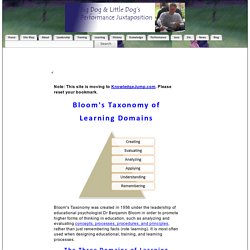
Please reset your bookmark. Bloom's Taxonomy was created in 1956 under the leadership of educational psychologist Dr Benjamin Bloom in order to promote higher forms of thinking in education, such as analyzing and evaluating concepts, processes, procedures, and principles, rather than just remembering facts (rote learning). It is most often used when designing educational, training, and learning processes. The Three Domains of Learning The committee identified three domains of educational activities or learning (Bloom, et al. 1956): Cognitive: mental skills (knowledge) Affective: growth in feelings or emotional areas (attitude or self) Psychomotor: manual or physical skills (skills) Since the work was produced by higher education, the words tend to be a little bigger than we normally use.
While the committee produced an elaborate compilation for the cognitive and affective domains, they omitted the psychomotor domain. Cognitive Domain. Bloom's Taxonomy. Bloom's Taxonomy Blooms Digitally. 4/1/2008 By: Andrew Churches.

ROCCSALT 2012: Tools for Blooms. Applying Bloom's Taxonomy. Bloom's Taxonomy of Learning Domains. Activities for Each Level of Bloom's Taxonomy. Bloom's Digital Taxonomy. Major Categories in the Taxonomy of Educational Objectives. Knowledge remembering of previously learned material; of terminology; specific facts; ways and means of dealing with specifics (conventions, trends and sequences, classifications and categories, criteria, methodology); universals and abstractions in a field (principles and generalizations, theories and structures): Knowledge is (here) defined as the remembering (recalling) of appropriate, previously learned information.

Defines; describes; enumerates; identifies; labels; lists; matches; names; reads; records; reproduces; selects; states; views; writes;. Comprehension: Grasping (understanding) the meaning of informational materials. Bloom's Taxonomy. Bloom’s Taxonomy: Bloomin’ Peacock. Tomorrow I am doing a training on the Treasures Supplement that I created over the summer.
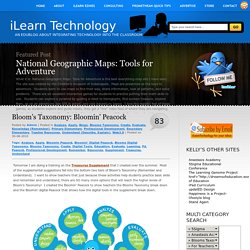
Most of the supplemental suggestions fall into the bottom two tiers of Bloom’s Taxonomy (Remember and Understand). I want to show teachers that just because these activities help students practice basic skills and remember and understand, there are SO many more options that will reach the higher levels of Bloom’s Taxonomy! I created the Bloomin’ Peacock to show teachers the Blooms Taxonomy break down and the Bloomin’ digital Peacock that shows how the digital tools in the supplement break down.
Below are the tools listed in my Bloomin’ Digital Peacock. Blooms Taxonomy Posters to Use in your Classroom. Blooms Taxonomy has been the subject of one of my first articles in Educational Technology and Mobile Learning.
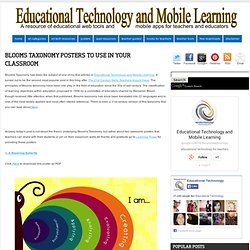
It turned out to be the second most popular post in this blog after The 21st Century Skills Teachers should Have. The principles of Blooms taxonomy have been into play in the field of education since the 50s of last century. The classfication of learning objectives within education proposed in 1956 by a committee of educators chaired by Benjamin Bloom , though received little attention when first published, Blooms taxonomy has since been translated into 22 languages and is one of the most widely applied and most often citered reference. There is even a 21st century version of this taxonomy that you can read about here. Anyway today's post is not about the theory underlying Bloom's Taxonomy but rather about two awesome posters that teachers can share with their students or pin on their classroom walls.All thanks and gratitude go to Learning Today for providing these posters. Great Blooms Taxonomy Apps for Both Android and Web 2.0.
Just a few days ago I posted a comprehensive list of educational iPad apps organized into awesome charts that teachers can print out and use separately.
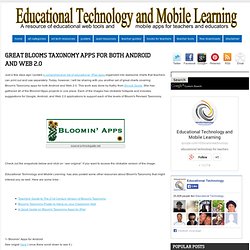
Today, however, I will be sharing with you another set of great charts covering Bloom's Taxonomy apps for both Android and Web 2.0. This work was done by Kathy from Shrock Guide. She has gathered all of the Bloomin'Apps projects in one place. Each of the images has clickable hotspots and includes suggestions for Google, Android, and Web 2.0 applications to support each of the levels of Bloom's Revised Taxonomy. Check out the snapshots below and click on ' see original ' if you want to access the clickable version of the image. Educational Technology and Mobile Learning has also posted some other resources about Bloom's Taxonomy that might interest you as well. 1- Bloomin' Apps for Android See origial Here ( once there scroll down to see it ) 2- Bloomin' Apps for Web 2.0 See original Here ( once there scroll down to see it )
Bloom’s Taxonomy: The 21st Century Version. So much have been written about Bloom’s taxonomy; one click in a search engine will flood your page with hundreds of articles all of which revolve around this taxonomy.
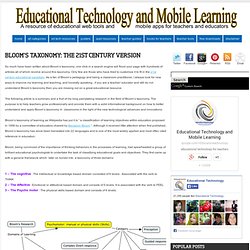
Only few are those who have tried to customize it to fit in the 21st century educational paradigm. Blooms Taxonomy with Apps. Bloom's Taxonomy According to Pirates of the Caribbean. Blooms Revised. Edorigami.wikispaces.com/file/view/Blooms+activity+analysis+2.pdf. Bloom's and ICT tools. Many teachers use Bloom's Taxonomy and Bloom's Revised Taxonomy in developing and structuring their teaching & learning experiences.

Bloom's Digital taxonomy is an attempt to marry Bloom's revised taxonomy and the key verbs to digital approaches and tools. This is not a replacements to the verbs in the revised taxonomy, rather it suppliments and supports these by including recent developments, processes and tools. This page looks at some specific examples of tools and match them to Bloom's Digital Taxonomy Many of these tools that are FOSS (Free or Open Source Software). These are in italics. Some tools are marked with abbreviations as they cover a variety of tools.Main pageTraditional and Digital approaches Benjamin Bloom developed, in the 1956 while working at the University of Chicago, developed his theory on Educational Objectives.
Files Web 2.0 Tutorials Without a doubt one of the best resources on the web for web2.0 Technologies is the commoncraft show.